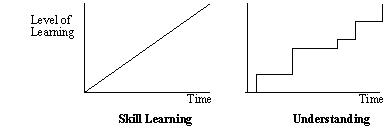Instructional design/Cognitive behaviors/Understanding/Page 4
Principles for Learning Meaningful Knowledge
[edit | edit source]How does understanding occur? David Ausubel, a pioneer in studying this type of learning, pointed out that two things are necessary for understanding to occur: (1) the content must be potentially meaningful, and (2) the learner must relate it in a meaningful way to his or her prior knowledge. For potentially meaningful knowledge to become meaningful knowledge to a learner, it is usually, according to Ausubel, subsumed under a broader, more inclusive piece of meaningful knowledge closely related to it. Understanding of the concept "sonnet" is enhanced when we learn that it is a kind of poem (assuming we understand what a poem is). The more distinct the new knowledge is from the relevant subsumer, the harder it is to understand. The key to understanding, it appears, is relating it to appropriate prior knowledge. But sometimes, particularly when one's understanding is incorrect, subsumption does not come easily ó it doesn't fit right. Then there is a restructuring of knowledge Ausubel calls "integrative reconciliation".
Schema theory extends Ausubel's theory of meaningful learning by identifying other types of relationships which help lend meaning to new knowledge. But the same two processes remain, only with different names: what Don Norman refers to as "accretion" (plugging new ideas into a schema) and "restructuring" (making important changes to a schema). He has also identified an intermediate process, which he calls "tuning" (making smaller changes to a schema), which shows that there is a continuum between these two extreme forms of understanding. Assimilation occurs when you plug new knowledge into an existing schema, whereas restructuring occurs when the new knowledge results in your reconceptualizing (significantly modifying a schema) in order to understand (reconcile conflicts with your prior knowledge).
Understanding is like a light bulbóit changes suddenly from darkness to lightóin contrast to the gradual process by which rote memorization and skill application occur (see Fig. 6.1 below). Small steps are taken when accretion occurs; medium steps when tuning occurs; and large steps (momentous insights) when restructuring occurs.

Figure 6.1. An important difference between understanding and skill application.
The issue of what is understanding is a difficult one. One view is that there are two major kinds of understanding: understanding things (concepts), and understanding how things change (principles, or causal models).
| Instructional Design | Cognitive Behaviors | < Back | Next > |

